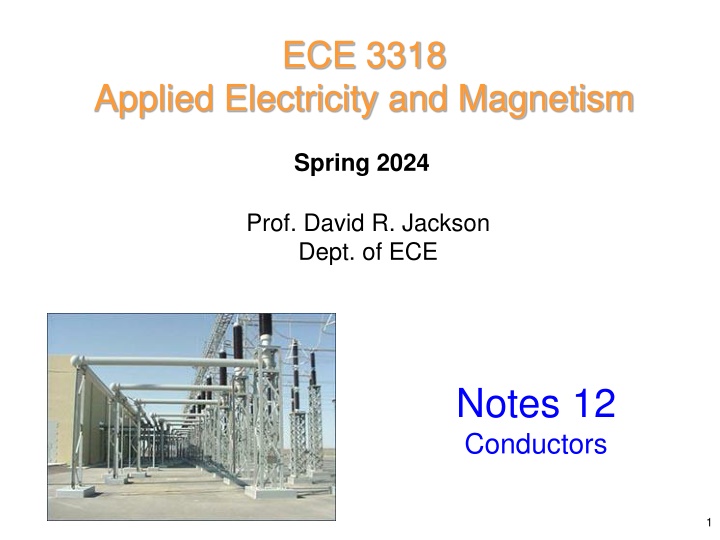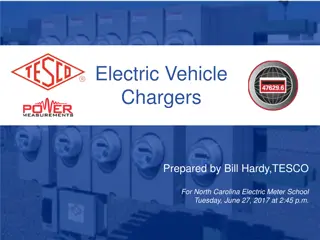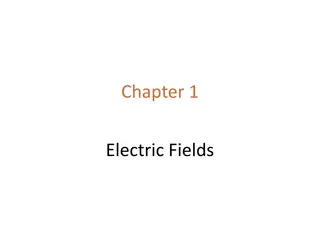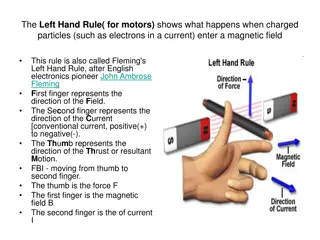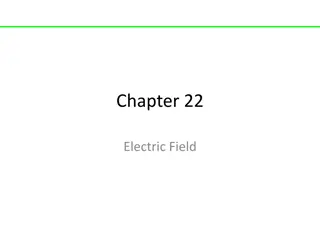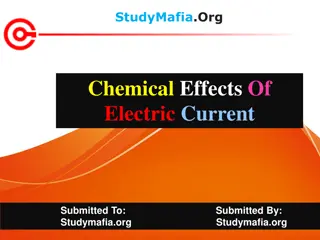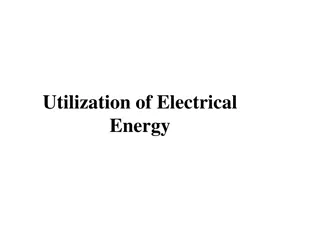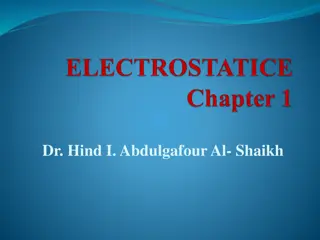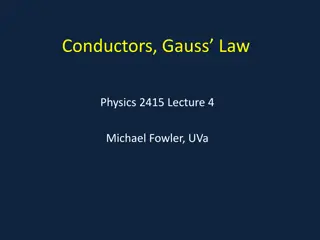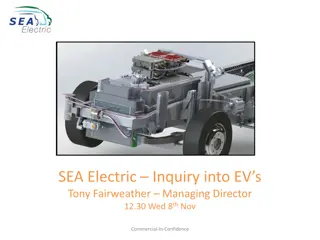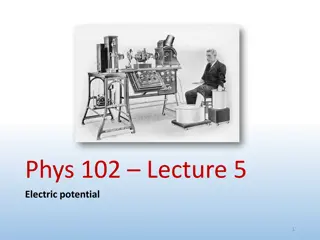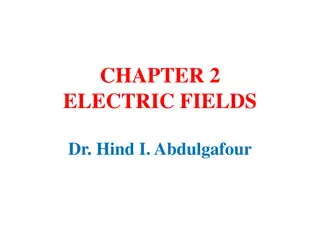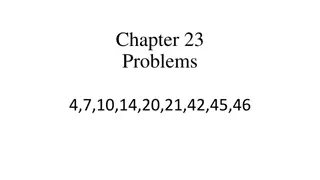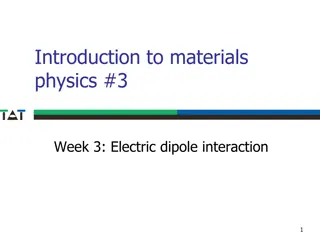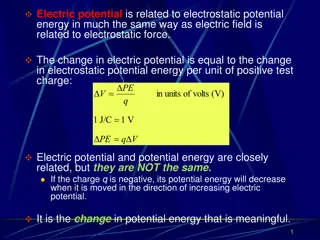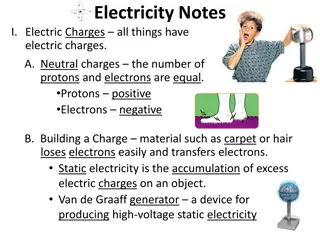Conductors and Perfect Electric Conductors
Discusses properties of conductors and perfect electric conductors including Ohm's Law, behavior inside a perfect conductor, potential on and inside a perfect conductor, electric field characteristics, and restrictions on surface charges.
Download Presentation

Please find below an Image/Link to download the presentation.
The content on the website is provided AS IS for your information and personal use only. It may not be sold, licensed, or shared on other websites without obtaining consent from the author.If you encounter any issues during the download, it is possible that the publisher has removed the file from their server.
You are allowed to download the files provided on this website for personal or commercial use, subject to the condition that they are used lawfully. All files are the property of their respective owners.
The content on the website is provided AS IS for your information and personal use only. It may not be sold, licensed, or shared on other websites without obtaining consent from the author.
E N D
Presentation Transcript
ECE 3318 Applied Electricity and Magnetism Spring 2024 Prof. David R. Jackson Dept. of ECE Notes 12 Conductors 1
Conductors Ohm s law = J E [S/m] 6.3 107 6.0 107 5.8 107 4.1 107 3.5 107 1.7 107 1.6 107 1.4 107 1.0 107 9.2 106 7.0 106 1.5 106 Material Silver Copper Copper (annealed) Gold Aluminum Zinc Brass Nickel Iron Tin Steel (carbon) Steel (stainless) Good electric conductors: >> 1 Perfect electric conductor (PEC): Note: Many of the properties derived for PECs hold very accurately for good conductors. http://en.wikipedia.org/wiki/Electrical_resistivity_and_conductivity 2
Perfect Electric Conductors Inside a perfect conductor, the electric field must be zero. Ohm s law: = J E or PEC = J / E PEC: Note: We assume that the current density cannot go to infinity. E 0 3
Perfect Electric Conductors (cont.) Inside and on a perfect conductor, the potential must be constant. E = 0 B A C Hence ( ) , , x y z B PEC = E dr = 0 V AB A =constant Note: The voltage drop integral is independent of the path, so we can choose a path that stays inside the conductor (where the electric field is zero). 4
Perfect Electric Conductors (cont.) Electric lines of flux must enter or leave a conductor perpendicular to it. In other words: Et= tangential electric field = 0 On surface of PEC: B = E dr = 0 V E r AB A Hence, E is perpendicular to rfor any small ralong the surface. A B r We choose a small path r in a tangential direction along the surface. PEC 5
Perfect Electric Conductors (cont.) Inside a PEC v = 0 Proof: Assume a point inside where v > 0 v> 0 inside small volume (since vis a continuous function). 0 Q encl S ++ ++ + + + D n dS = Q encl PEC S = 0 0 Q Hence Contradiction ! encl 6
Perfect Electric Conductors (cont.) Only s on the surface is allowed for a PEC. http://en.wikipedia.org/wiki/Electrostatics 7
Properties of Conductors Summary of Properties for PEC E = 0 ( inside) + + + + + = constant ( inside and on surface) + PEC v = 0 ( + inside) + + + + + ( E is to surface on surface ) + 8
Faraday Cage Effect Inside of a hollow PEC shell in statics: There is no electric field. There is no s on the inner surface. Static electric field source - q - - PEC + - s + E = 0 - Note: + The Faraday cage does not have to be grounded. + + This is a shielded region (no electric field). 9
Faraday Cage Effect (cont.) Proof of Faraday cage effect Hollow cavity + + + + Outline of proof: PEC + The electric field is zero inside the conductor. + + The potential on the boundary of the inner hollow cavity is constant. E = 0 + + The uniqueness theorem then says that the potential must be a constant throughout the hollow cavity region (see the next slide). + + + + The electric field is then zero inside the hollow cavity as it comes from the gradient of the electric field. PEC shell Note: The uniqueness theorem is discussed on the next slide. 10
Faraday Cage Effect (cont.) Uniqueness Theorem If = V0 (a constant) everywhere on the boundary S, then (x,y,z)= V0everywhere inside the region. Given: = V0 (a constant) on the boundary Surface S (closed surface) ( ) = , , x y z V A proof of the uniqueness theorem is given in the textbook. 0 11
Faraday Cage: Practical Conductor In static equilibrium, the Faraday cage still works, even with a practical good conductor (finite conductivity): ( ) = = : 0 0 J E Static equilibirum inside metal Ohm's law Static electric field source - q - - Assumption: It is assumed that the shell is not connected to any external wires or sources. E = 0 - E = 0 inside metal The rest of the proof works the same way. Conducting metal shell (finite conductivity) 12
Faraday Cage: Example Faraday cage inside of a parallel-plate capacitor + + + + + + + - + - + + + + + + PEC - - 00 + + + + - - - - - - - - - - - - - - No electric field inside Faraday cage 13
Faraday Cage: Note on Magnetic Field A Faraday cage made of a good conductor does not block a static magnetic field! Copper (nonmagnetic) S N H 0 Note: A high permeabilitymaterial will act as a good shield for a static magnetic field (e.g., Mu-metal, r=100,000). 14
Faraday Cage: Note on Magnetic Field High permeability shield ( ) 1 r r 1 H 0 S N A Faraday cage made of a high permeabilitymaterial will act as a good shield for a static magnetic field. 15
High-Frequency Shielding At high frequencies, both electric and magnetic fields are blocked by the skin effect. E 0 H 0 Radiating antenna source Skin depth: 2 = Thickness >> To be a good shield, the thickness of the shield should be large compared to a skin depth. This situation is discussed in ECE 3317 (skin-depth effect). 16
Summary on Shielding When will a closed metal shield (Faraday cage) be an effective shield? A good conductor ( >> 1) will block all high-frequency signals (skin effect). In statics, a good conductor will block the electric field (Faraday Cage effect). In statics, a good conductor will not necessarily block the magnetic field. In statics, a high-permeability material ( r >> 1) will block the magnetic field. , r Faraday cage (conductive shield) 17
Faraday Cage Effect (cont.) Faraday-cage effect They are safe from the Tesla coil! 18
Faraday Cage Effect (cont.) Faraday-cage effect She is safe from the Van de Graaff generator! (Boston Science Museum) 19
Faraday Cage Effect (cont.) The importance of being insulated: She is insulated from ground! (Boston Science Museum) 20
Faraday Cage Effect (cont.) + + + + + + + + + + + + + + + + + + _ _ _ _ _ _ _ _ _ _ _ _ _ _ _ _ _ _ 1) Occupants are pretty safe (but let the charge dissipate before you get out!) 2) Occupants are not very safe Earth Earth 21
Faraday Cage Effect (cont.) Faraday Cage Shielded Room Self-standing modular Faraday cage Superior screening of RF/LF/HF signals, e.g. for R&D, TEMPEST and Testing purposes. The modular Faraday cage is designed to meet or even exceed the vast majority of shielding requirements. The system is constructed of shielded modular panels, available in either standard-sized or custom-designed panels to meet exact specifications in government, industry, research and development, university or hospital use. The system is completely self-standing (independent of the host building). The modular panels can be shipped and assembled by the customer or under supervision of our engineers, anywhere in the world. Applications RF/LF/HF test and measurements EMC test labs Wireless product testing EMI/RFI shielded server rooms TEMPEST / Sensitive information protection HEMP & EMP protection Neuroscience laboratories Cellular communication devices Immunity & emission test chambers Anechoic chambers MRI rooms Neurology lab etc... 22 http://www.directindustry.com/prod/holland-shielding-systems-bv/faraday-cages-modular-35048-1031291.html
Shielding and Grounding a b Neutral (no charge) Start with Spherical PEC shell PEC Note: The principles illustrated here apply to any shape cavity, but for modelling purposes it is simplest to use a spherical cavity. Drill hole and insert point charge, then solder hole. q PEC a b q Find E: Neutral shell (no charge) PEC 23
Shielding and Grounding (cont.) D ndS = Q (a) r < a encl S D ( ) = 2 4 r q r q = r E a b 2 4 r q 0 E = 0 (b) a < r < b (PEC) PEC ( ) Neutral shell = 2 4 D r q (c) r > b r Three possible Gaussian surfaces are shown. q = r E 2 4 r 0 24
Shielding and Grounding (cont.) Neutral shell q PEC q = r E (outside metal) 2 4 r 0 The neutral metal shell does not block the static electric field coming from the inside ! (The shell would be a good shield for high-frequency fields coming from the inside, however, due to the skin-depth effect.) 25
Shielding and Grounding (cont.) Find QA, QB: + + Q A + - - + q - Q B - - - - + + PEC + + Neutral shell + + + + + + + - - - q + + - - Q = Q Q Neutral shell: - A - - A B + Q + PEC + B + + + + 26
Shielding and Grounding (cont.) D n dS = Q + + + encl + + PEC S + + - ( ) - - = 2 4 D r Q q + Q + - - encl r - Q - B - A + + The electric field is zero inside of a PEC. + + + + + encl=0 Q so S + = 0 Q q A Gaussian surface is chosen inside the metal shell. or A Hence = Q q A = + Q q We then also have (neutral shell) B 27
Shielding and Grounding (cont.) + + PEC + + + + q + + - - - q + - - + q - - - + + + + + + + Flux picture showing the charge on the surfaces Note: Flux lines go from positive charges to negative charges. (Also, they go from higher potential to lower potential.) 28
Shielding and Grounding (cont.) Next, ground the shell: = : 0 r b E PEC G B Q - - - Proof: - - - - - q We can invoke the uniqueness theorem, considering the outside of the shell, the wire, the earth, and infinity to form the boundary S of our region: the potential everywhere outside the shell is a constant. E = 0 PEC wire Note: Grounding has not affected the charge on the inner surface of the shell. Earth The earth is modeled as a big conductor. 29
Shielding and Grounding (cont.) Charge on outer surface: = : 0 r b E G B Q D ndS = Q PEC encl - - - S q - - - - = 0 Q - encl q ( ) + + = G B 0 q q Q S PEC wire Hence Q = G B 0 Earth 30
Shielding and Grounding (cont.) Q = G B 0 PEC Charge on outer surface (cont.): - - q - - - - - q - + + + E = 0 + + + = + + Q q + PEC B + + - q - - PEC wire q + - - + - + - q - + + + + + + + Earth After grounding Neutral shell before grounding The charge q on the outer surface has flowed down to ground. 31
Summary of Shielding & Grounding in Statics q - - - PEC Effect # 1: Faraday cage effect + + - There is no static field on the inside (does not require grounding). E = 0 - + + + Effect # 2: Static field penetration + + + An ungrounded shield does not block the static electric field of an insidesource. + + + q PEC + + - - - q + - - + - - q - + + E 0 + + + + + 32
Summary of Shielding & Grounding in Statics (cont.) Q = G B 0 PEC - - - q - - - - - E = 0 Effect # 3: Grounding A grounded shield removes the static electric field in the exterior region and removes static charge buildup from the outer surface. Conducting wire (This assumes that there are no charges in the outside region.) Earth 33
Summary of Shielding & Grounding in Statics (cont.) PEC E = 0 Grounded Faraday cage (effect #1 + effect #3) E = 0 A grounded hollow Faraday cage has no static field anywhere. Conducting wire Earth 34
Comments on Grounding* Static Fields Grounding removes static charge build up on objects. Grounding removes electric fields produced from any static charge build up. This is good for safety (e.g., when operating in explosive environments.) This is good for reducing noise in sensitive measurements. Power line frequency Grounding is good for the safety of AC equipment (preventing shocks from the AC line voltage). *This topic was also discussed in Notes 5. 35
Summary of Shielding and Grounding Principles: 1) A hollow faraday cage (closed metal shell) will have no static fields inside. A hollow Faraday cage will only block magnetic fields if the metal has a high r. 2) 3) A metal object will have no static charge or fields on the outside if it is grounded. 4) A piece of power equipment with a metal case will be safe if properly grounded. 5) A closed metal shield blocks all high-frequency fields if it is thick compared to a skin depth. Examples: 1) You are usually safe inside your car if it get struck by lightning. 2) Magnetically shielded rooms for MEG measurements are made of materials such as Mu-metal. 3) Oscilloscopes should be grounded to avoid static interference in the measurements. 4) Always make sure that power equipment with a metal case has a grounding plug and is properly grounded. 5) Don t expect to get cell phone reception inside of a metal building unless it has windows or openings. 36
